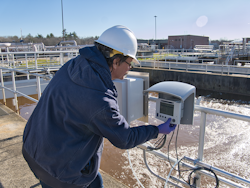
Wastewater facilities are continually looking for ways to optimize their process and save on operating expenditures. In recent years, ammonia-based aeration control (ABAC) has been sought after to be the next advancement in aeration control technology. With ABAC, facilities have seen drastic reductions in blower usage and energy savings of around 10-20% over dissolved oxygen control, including other benefits like reduced carbon dosing and alkalinity demand. The concept of ammonia-based aeration control is simple: utilize continuous ammonium (NH3/NH4+) measurements to control aeration in real time to maintain an ammonium setpoint. The amount of air provided to the basins is just enough to meet their NPDES permit limit while eliminating instances of over-aeration.
A crucial aspect of implementing an ammonia-based aeration control system is ammonium sensor placement. Should the control sensor be near the influent of the activated sludge basins, at the effluent of the activated sludge basins, or somewhere in between? That is the question the team at Brockton Advanced Water Reclamation Facility in Massachusetts set out to answer for their facility upgrade.
Download the case study to learn more.
Download Case StudyVisit the YSI, a Xylem brand Storefront





